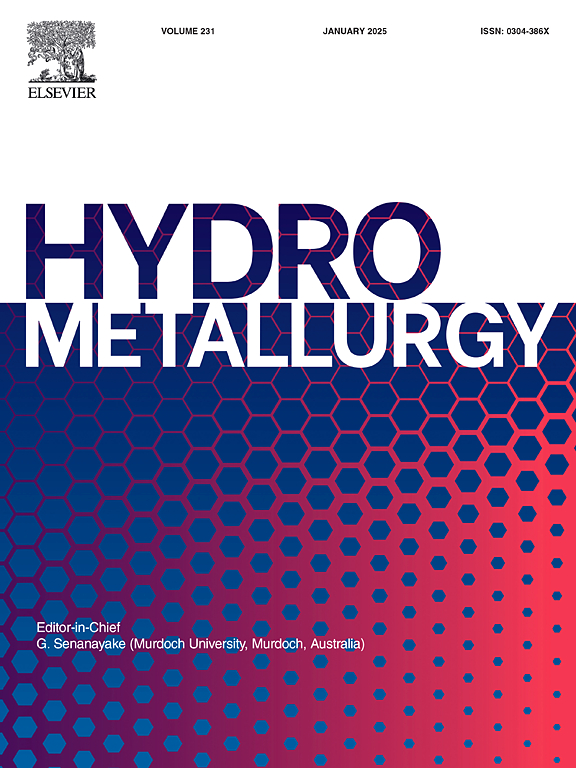难处理金矿酸性氧化条件下黄铁矿、毒砂中铁、砷的形态分布及物相变化的热力学分析
IF 4.8
2区 材料科学
Q1 METALLURGY & METALLURGICAL ENGINEERING
引用次数: 0
摘要
本文利用现有的热力学数据,对Fe-S-O-H和Fe-As-S-O-H体系在低于300℃条件下的物质分布和稳定相图进行了新的研究。这个温度范围对这个系统很重要,因为它告诉铁和砷在复杂难熔矿石的压力氧化和砷的固定中的行为。根据建立的模型计算,在25°C下,砷酸盐的稳定形式——纯铁矾(FeAsO4∙2H2O)的溶解度参数与pH值低于2的实验结果吻合良好,但在pH值高于2时,其溶解度参数相差高达两个数量级。在这项工作中,通过将水合铁的沉淀和与铁球石的平衡纳入模型,缩小了这一差距,表明水合铁和不一致溶解在铁球石溶解度中的关键作用。此外,在pH 0 ~ 4之间,Fe(II)在Fe-As- s- o - h体系中以FeH2AsO4+形式存在的稳定性范围比Fe- s- o - h体系大得多,表明Fe和As的络合作用可以显著改变其稳定性和水迁移率。碱性硫酸铁矿物,如纤维铁氧体和偏高锰矿,在pH值低于1.5时表现出增强的稳定性。相反,黄钾铁矾在酸性环境中随着温度的升高(高达220°C左右)显示出更高的稳定性,然后才发生逆转。这些新发现为铁和砷的热力学行为提供了有价值的新见解,推动了地球化学建模和矿物稳定性领域的发展。本文章由计算机程序翻译,如有差异,请以英文原文为准。
Thermodynamic analysis of iron and arsenic species distribution and phase variation of pyrite and arsenopyrite under acidic oxidation relevant to refractory gold ores
This paper presents a novel investigation into the species distribution and stability phase diagrams for the Fe-S-O-H and Fe-As-S-O-H systems under conditions below 300 °C, using available thermodynamic data. This range of temperatures is important for this system, as it informs the behavior of iron and arsenic species in the pressure oxidation of complex refractory ores and in the fixation of arsenic. When calculated based on the established models, the estimated solubility parameters for pure scorodite (FeAsO4∙2H2O), a stable form of arsenate, at 25 °C were in good agreement with experimental results below pH 2, but diverged by up to two orders of magnitude above pH 2. In this work, this gap has been narrowed by incorporating the precipitation of ferrihydrite and the equilibrium with scorodite into the model, indicating the critical role of ferrihydrite and incongruent dissolution in scorodite solubility. Furthermore, between pH 0 and 4, the temperature-driven increase in the stability range of Fe(II) in the form of FeH2AsO4+ in the Fe-As-S-O-H system is much larger compared to the Fe-S-O-H system, demonstrating that the complexation of Fe and As can significantly alter its stability and aqueous mobility. Basic ferric sulfate minerals, such as fibroferrite and metahohmannite, exhibit enhanced stability as the pH decreases below 1.5. Conversely, jarosite displays increased stability in acidic environments with rising temperatures, up to around 220 °C, before undergoing a reversal. These novel findings provide valuable new insights into the thermodynamic behavior of iron and arsenic species, advancing the field of geochemical modeling and mineral stability.
求助全文
通过发布文献求助,成功后即可免费获取论文全文。
去求助
来源期刊

Hydrometallurgy
工程技术-冶金工程
CiteScore
9.50
自引率
6.40%
发文量
144
审稿时长
3.4 months
期刊介绍:
Hydrometallurgy aims to compile studies on novel processes, process design, chemistry, modelling, control, economics and interfaces between unit operations, and to provide a forum for discussions on case histories and operational difficulties.
Topics covered include: leaching of metal values by chemical reagents or bacterial action at ambient or elevated pressures and temperatures; separation of solids from leach liquors; removal of impurities and recovery of metal values by precipitation, ion exchange, solvent extraction, gaseous reduction, cementation, electro-winning and electro-refining; pre-treatment of ores by roasting or chemical treatments such as halogenation or reduction; recycling of reagents and treatment of effluents.
 求助内容:
求助内容: 应助结果提醒方式:
应助结果提醒方式:


